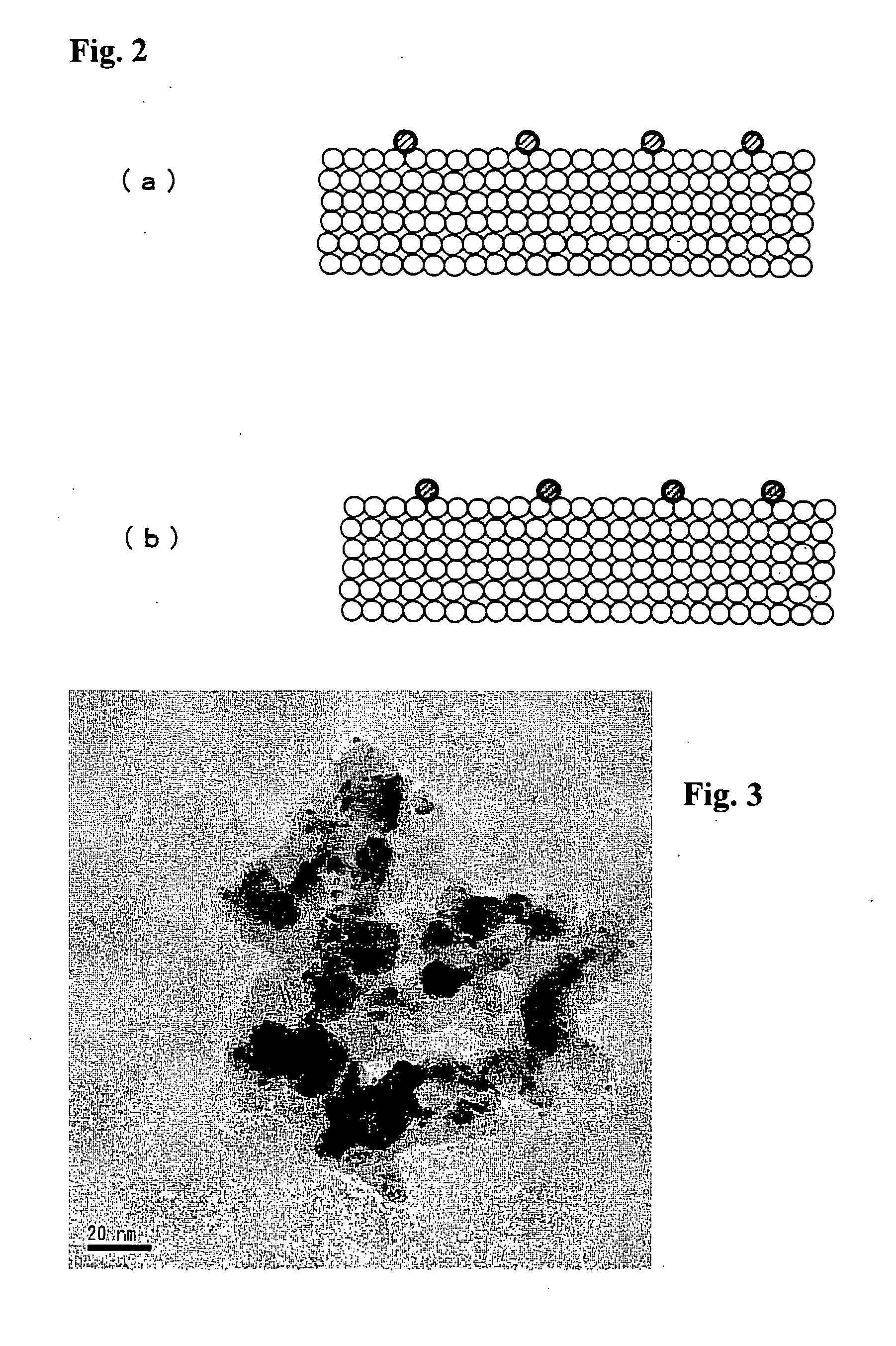Catalyst
- Summary
- Abstract
- Description
- Claims
- Application Information
AI Technical Summary
Benefits of technology
Problems solved by technology
Method used
Image
Examples
example 1 (
Pt / CZO Catalyst)
[0038] A metal salt solution was prepared by diluting 22.01 g of a nitric acid solution of dinitrodiamine platinum (Pt concentration: 4.54 wt %) with distilled water to 100 mL in a measuring flask. On the other hand, 2.21 g of polyethylene imine (PEI) having an average molecular weight of 50000 were diluted with distilled water to 100 mL in a measuring flask. And 10 mL of the metal salt solution and 4 mL of the PEI solution were mixed and stirred, the mixed solution was then added dropwise to a solution in which 10 g of CZO were dispersed, ammonia was added dropwise until pH 10 was obtained, and a hybrid complex was caused to be adsorbed on a CZO carrier. The surface area of this CZO catalyst is 67 m2 / g and the cerium concentration is 40 mol %.
[0039] Next, a dispersion liquid in which this carrier is dispersed was heated to 70° C., 30 mL of an aqueous solution of 2.5 wt % hydrazine were added dropwise for a duration of one hour, and the dispersion liquid was held at...
example 2 (
Pt / Pd / CZO Catalyst)
[0040] A mixture of 17.84 g of a nitric acid solution of dinitrodiamine platinum (Pt concentration: 4.54 wt %) and 4.32 g of a nitric acid solution of palladium dinitrate (Pd concentration: 4.40 wt %) was prepared, and this mixture was diluted with distilled water to 100 mL in a measuring flask, whereby a metal salt solution was obtained. And the same PEI solution as in Example 1 was added to 10 mL of this precious metal salt solution and other operations were performed by the same process as in Example 1, whereby a Pt / Pd / CZO catalyst was obtained. When the catalyst after drying was also observed under a TEM, the presence of particles of about 3 nm was verified. When an analysis by EDX was performed, the presence of Pt and Pd was verified within single particles.
example 3 (
Pt / Rh / CZO Catalyst)
[0041] A mixture of 18.06 g of a nitric acid solution of dinitrodiamine platinum (Pt concentration: 4.54 wt %) and 1.81 g of a solution of rhodium nitrate (Rh concentration: 10.0 wt %) was prepared, and this mixture was diluted with distilled water to 100 mL in a measuring flask, whereby a metal salt solution was obtained. And the same PEI solution as in Example 1 was added to 10 mL of this precious metal salt solution and other operations were performed by the same process as in Example 1, whereby a Pt / Rh / CZO catalyst was obtained. When the catalyst after drying was also observed under a TEM, the presence of particles of about 3 nm was verified. When an analysis by EDX was performed, the presence of Pt and Rh was verified within single particles.
PUM
| Property | Measurement | Unit |
|---|---|---|
| Particle size | aaaaa | aaaaa |
| Specific surface area | aaaaa | aaaaa |
| Temperature | aaaaa | aaaaa |
Abstract
Description
Claims
Application Information
 Login to View More
Login to View More - R&D
- Intellectual Property
- Life Sciences
- Materials
- Tech Scout
- Unparalleled Data Quality
- Higher Quality Content
- 60% Fewer Hallucinations
Browse by: Latest US Patents, China's latest patents, Technical Efficacy Thesaurus, Application Domain, Technology Topic, Popular Technical Reports.
© 2025 PatSnap. All rights reserved.Legal|Privacy policy|Modern Slavery Act Transparency Statement|Sitemap|About US| Contact US: help@patsnap.com



